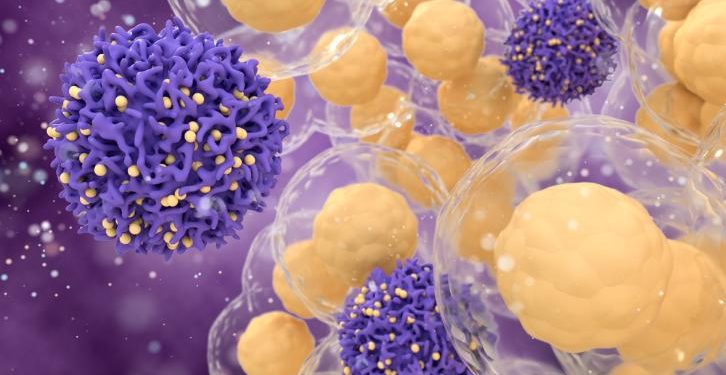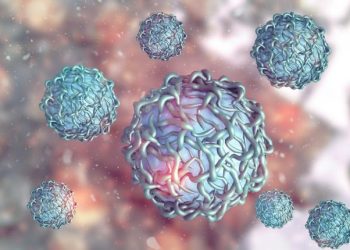Cancer that forms in the blood-forming stem cells of bone marrow (the soft, sponge-like tissue in the center of most bones). Bone marrow cancers include multiple myeloma and leukemia.
Myeloma happens when plasma cells grow at an uncontrollable rate and crowd out healthy white blood cells, red blood cells and platelets.
Diagnosis
Bone marrow is the spongy tissue and fluid inside your bones that makes blood cells. Cancers start in the bone marrow and spread to other parts of the body. Blood tests can help doctors find out if you have cancer. A doctor may also order a bone marrow test to check for bone marrow cancer. You’re usually awake for this test, but you might have medicine to make you drowsy (sedation). A doctor puts a hollow needle into your lumbar spine or pelvic bone and draws up liquid marrow with a syringe. They might also do a bone marrow trephine biopsy, in which they remove a thin 1 or 2 cm core of bone marrow with a needle. Both tests are safe for most people. You might feel a deep, aching pain for a few seconds, similar to a toothache.
If the cancer is not treated, it can spread to other parts of the body and cause life-threatening complications. The type of treatment you receive depends on the type and stage of the cancer, your general health and other factors. A doctor will discuss your options and treatment plan with you.
Some types of bone marrow cancer are curable. For example, Hodgkin lymphoma is usually cured if it’s caught early and treated quickly. It’s also a good idea to talk with your doctor about getting regular screening for blood and bone marrow cancers, especially if you have certain risk factors for these cancers.
For example, if you have a family history of multiple myeloma, you’re more likely to get this type of cancer. You’re also more likely to get it if you’ve had high-dose radiation exposure or are over 60 years old.
There are many different kinds of leukemia and other blood cancers. The prognosis — your chance of living with the disease for at least five years after diagnosis — is different for each type. The outlook depends on the type of cancer, how advanced it is when you’re diagnosed and whether or not your cancer comes back after treatment. These survival rates are for adults. The rates for children are lower because childhood cancers are less common.
Treatment
The outlook (prognosis) for people with bone marrow cancer can vary. It depends on the type and stage of cancer, as well as how it responds to treatment. The earlier cancer is diagnosed, the greater the chance of a good outcome.
Blood cancers start in the spongy tissue inside your bones called the marrow. Marrow makes blood cells, including white blood cells that fight infection and disease and red blood cells that carry oxygen to all parts of your body. Blood cancers affect the marrow’s ability to make healthy blood cells. They also prevent your blood from doing its job by attacking healthy cells and blocking their growth.
Many of the same treatments used to treat other types of cancer can be used to treat bone marrow cancer. These treatments include chemotherapy, radiation therapy and sometimes surgery.
Your doctor will need to know your general health history and do a physical exam before deciding on a treatment plan for you. Your doctor will also order a series of tests to check your blood and marrow for signs of cancer. These may include a complete blood count (CBC), a bone marrow aspiration and biopsy, an imaging test, such as a computed tomography (CT) scan or magnetic resonance image (MRI), and a positron emission tomography (PET) scan.
A positron emission tomography scan shows how your body is using its energy, which can help identify tumors that are blocking the flow of blood through them. A CT or MRI scan can show the location of a tumor and how it’s affecting the marrow.
X-rays can’t diagnose bone marrow cancer, but they can show if cancer has spread from the marrow to other organs.
You’ll also need to have blood and urine tests to see if you have any infections or other problems that might be causing your symptoms.
A hematologist or oncologist will review the results of your tests and talk with you about your treatment options. They may also recommend a blood stem cell transplant from a donor to replace your cancerous bone marrow cells with healthy ones from another person. This treatment can reduce the risk of graft-versus-host disease, in which the donor’s blood stem cells attack the recipient’s body.
Side effects
A person with bone marrow cancer may experience side effects depending on the type of cancer and treatment. Bone marrow is the soft, sponge-like tissue inside the center of most bones. It makes blood cells that help carry oxygen to the rest of the body and clot the blood to stop bleeding. Cancer forms in the bone marrow when certain types of blood cells grow abnormally or at an out-of-control rate. These include multiple myeloma, leukemias and lymphomas.
Many of the treatment options for bone marrow cancer are also used to treat other cancers. Some of these treatment regimens can cause severe or life-threatening side effects. Because of this, it is important to talk openly with your doctor about any symptoms you are experiencing. Often, these will go away after your treatment is finished, or they will become less serious as the time passes.
There are several different treatments for bone marrow cancer, including chemotherapy, radiation therapy and bone marrow transplantation. Your doctor will recommend the type of treatment that is best for you.
A bone marrow transplant replaces the damaged marrow with healthy marrow from another source. The marrow can come from your own body (autologous transplant) or from a donor (allogeneic transplant). Your doctor will discuss the benefits and risks of each type of transplant with you.
During a bone marrow/stem cell transplant, you will receive intensive medical treatment before the new stem cells are infused into your body. This includes chemotherapy and radiation therapy to destroy the cancerous cells. This treatment can suppress your immune system, making you more likely to get infections.
After a bone marrow/stem-cell transplant, your blood counts will rise and you should begin to feel better. You will need to continue to visit your health care team for regular checkups and tests to monitor the transplantation process and your overall health.
If you are receiving a bone marrow/stem-cell treatment, it is important to tell your doctor about any symptoms or signs of a problem as soon as they occur. This will allow your doctor to begin treating the problem before it gets worse.
Prevention
The spongy material inside your bones, called bone marrow, produces blood cells. These cells mature into different kinds of blood cells as your body needs them: white blood cells that fight infection, red blood cells that carry oxygen to tissues throughout the body and platelets that form blood clots to control bleeding. Most blood cancers, also known as hematologic cancers, start in the bone marrow and interfere with how your blood cells work. The three main types of blood cancer are leukemia, lymphoma and myeloma.
Bone marrow cancer occurs when abnormal blood stem cells develop into the wrong kind of blood cell. These cancerous cells can crowd out healthy blood cells and prevent them from performing their functions, such as fighting infection or preventing serious bleeding after minor scrapes and bruises.
Most blood cancers start in the bone marrow, but some cancers can form in any part of the lymphatic system or blood. The two most common types of blood cancer are leukemia and multiple myeloma.
In leukemia, normal blood stem cells develop into cancerous cells that can spread to other parts of the body. In multiple myeloma, the bone marrow makes too many plasma cells. Plasma cells are immature white blood cells that are sent out to mature in other areas of the body. These cells produce proteins called antibodies, which help your body fight infection. Multiple myeloma cells make a large number of these abnormal antibodies, which build up and block blood flow, causing pain and other symptoms.
A type of bone marrow transplant replaces your blood-forming stem cells with healthy ones from another person. A matched donor may be a parent or sibling with the same genetic makeup or a stranger found in national bone marrow registries.
UC Davis researchers have developed a breakthrough material that helps scientists better understand how osteosarcoma tumors grow in the context of the bone marrow. Called engineered bone marrow (eBM), it allows researchers to test how various therapies affect the growth of osteosarcoma and other bone marrow cancers in a realistic environment. This information can lead to more effective treatment for patients with this difficult-to-treat type of cancer.









